How Heinrich Rudolf Hertz revealed the invisible world
Loading...
Where has Google's logo disappeared to? The search engine giant swapped out its regular banner Wednesday for a Google doodle in honor of Heinrich Rudolf Hertz. The German physicist – whose work is crucial to television, radio, and Wi-Fi – would have turned 155 today.
Like many of Google's best doodles, this wave logo holds a double meaning. Sure, it winks at Hertz's history in electromagnetism (we'll explain all of that in a moment). But the undulating curves also hide a message, one you may never notice unless you take the time to look.
The waves form a repeating pattern: There's a large blue curve, followed by a shallow red, shallow yellow, deep blue, skinny green, and one final red curve. Those lines match the general shape of Google's traditional logo: Uppercase blue G, small Os, a lowercase g, a skinny green L, and a red E. It's not the most difficult code to decipher, but Google's doodle serves as a lovely metaphor for Hertz's work.
Namely, Hertz earned his fame by discovering what had always been there.
Our story starts in 1873, when a Scottish physicist named James Maxwell tried to convince people that light, electricity, and magnetism were all versions of the same phenomenon. It was a weird idea at the time. How could the invisible power of magnets go hand-in-hand with the radiant glow of candlelight? They're obviously different to the human eye, but actually quite similar in hidden ways.
Maxwell was the first to figure out that light moves like a wave, just as magnetism and electricity move through the "electromagnetic field." This was a huge breakthrough – it made sense of the invisible world in the same way that Isaac Newton and his falling apple unified the visible world. Maxwell's math checked out, yet he couldn't prove that his ideas were true. He challenged other scientists to come up with experiments that could demonstrate this invisible science to the naked eye.
A decade later, Hertz found a way.
In his lab, the German scientist rigged up two tiny brass spheres, placed very close to one another. When he electrified them, sparks leaped from one ball to the other. If Maxwell was correct, these sparks should send invisible waves radiating through the air. To test the theory, he needed to build a receiver. This second instrument consisted of a curved wire that almost made a full circle, except for a tiny gap at the top. He placed the transmitter and the receiver several yards apart and made sure that nothing connected the two. Sure enough, when sparks shot through the transmitter, invisible waves traveled through the air, lighting up new sparks on the receiver.
Hertz went on to prove that these waves move at the speed of light, that they can be reflected by some materials, and could pass through others.
While this research eventually led to radio, radar, and broadcast TV, Hertz did not initially understand the magnitude of his discovery.
"It’s of no use whatsoever," he once told a student. "This is just an experiment that proves Maestro Maxwell was right, we just have these mysterious electromagnetic waves that we cannot see with the naked eye. But they are there."
By allowing the world to finally see these invisible forces, Hertz became famous. The International Electrotechnical Commission decided in 1930 that his name would become a unit of frequency. The hertz (or Hz) measures "cycles per second." For example, a 60 Hz TV runs at up to 60 frames per second.
Despite this global fame, the Nazis tried to expunge Hertz's name from history. While Hertz identified as a Lutheran, his father grew up as a Jew.
"Hertz’s reputation was actively denigrated by the Nazis, who forced his wife and daughters to flee Germany because, despite strong Lutheran roots, they were considered Jews," writes the Institute of Electrical and Electronics Engineers in its profile of Hertz. "One Nazi functionary attempted to overturn the use of the term 'Hertz,'... He suggested to the Physical Society of Berlin that instead they use the term 'Helmholtz,' [after Hertz's teacher Hermann von Helmholtz] which would cleverly maintain the abbreviation 'Hz' for the benefit of foreign colleagues. Despite the climate of anti-Semitism, German scientists refused to go along with this plan. 'Hertz' remained and remains in use both in Germany and around the world."
For more on how technology intersect daily life, follow Chris on Twitter @venturenaut.
[Editor's note: The original version of this post mistakenly said that the final curve in Wednesday's Google doodle was yellow. Both it and the corresponding E in Google's name are red.]





